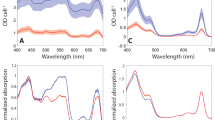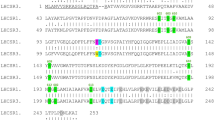Abstract
The prasinophycean alga Mantoniella squamata uses in vivo an incomplete violaxanthin cycle with antheraxanthin accumulating during periods of strong illumination (1). Antheraxanthin enhances thermal dissipation of excessively absorbed excitation energy. This process is supposed to take place in the light harvesting system of Mantoniella that shows a different organization than that of higher plants. It contains only one light harvesting complex that serves as antenna for both photosystems I and II (2). Minor Chi a/b binding PS LI proteins, that are discussed to bind the majority of the xanthophyll cycle pigments in higher plants (3), are not present. It is the aim of the present study to extend the findings of Wilhelm et al. (4) that the LHC of Mantoniella is the major binding site for the algal xanthophylls, violaxanthin included. We used sucrose density centrifugation in combination with HPLC based pigment analysis to clarifiy the localization of the xanthophyll cycle pigments in the different pigment protein complekes of Mantoniella. Purification of pigment proteins with either dark-adapted or illuminated intact cells as starting material served to answer the question if a conversion from violaxanthin to antheraxanthin takes place in the light harvesting complex. Furthermore we were interested in finding out if the pigment protein coupling changes in the presence of epoxidized or deepoxidized xanthophyll cycle pigments.
Preview
Unable to display preview. Download preview PDF.
Similar content being viewed by others
References
Goss, R.; Böhme, K. and Wilhelm, C. (1998) Planta 205, 613–621
Schmitt, A.; Herold, A.; Welte, C.; Wild, A. and Wilhelm, C. (1993) Photochem. Photobiol. 57, 132–138
Goss, R.; Richter, M. and Wild, A. (1997) J. Plant Physiol. 151, 115–119
Wilhelm, C.; Kolz, S.; Meyer, M.; Schmitt, A.; Zuber, H.; Egeland, E.S. and Liaaen-Jensen, S. (1997) Photosynthetica 33, 161–171
Müller, D. (1962) Bot. Mar. 4, 140–155
Laemmli, U. (1970) Nature 227, 680–685
Green, B.R. and Durnford, D.G. (1996) Annu. Rev. Plant Physiol. Plant Mol. Biol. 47, 685–714
Ruban, A.V.; Young, A.J.; Pascal, A.A. and Horton, P. (1994) Plant Physiol. 104, 227–234
Havaux, M. and Gruszecki, W.I. (1993) Photochem. Photobiol. 58, 607–614
Author information
Authors and Affiliations
Editor information
Editors and Affiliations
Rights and permissions
Copyright information
© 1998 Springer Science+Business Media Dordrecht
About this chapter
Cite this chapter
Goss, R., Wilhelm, C. (1998). In Mantoniella Squamata Deepoxidized Xanthophyll Cycle Pigments Show a Tighter Pigment Protein Coupling than the Respective Epoxidized Forms. In: Garab, G. (eds) Photosynthesis: Mechanisms and Effects. Springer, Dordrecht. https://doi.org/10.1007/978-94-011-3953-3_543
Download citation
DOI: https://doi.org/10.1007/978-94-011-3953-3_543
Publisher Name: Springer, Dordrecht
Print ISBN: 978-0-7923-5547-2
Online ISBN: 978-94-011-3953-3
eBook Packages: Springer Book Archive




